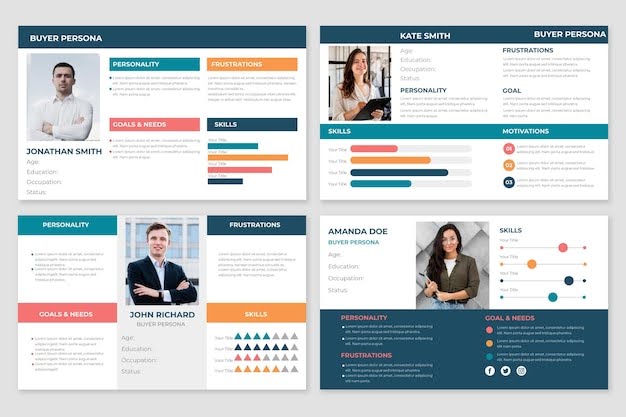How to Create Effective User Personas for B2B SaaS Products with Example and Template
-
Charles Adom
- 10 min read

 User personas play a crucial role in understanding and catering to the needs of your target audience. For B2B SaaS products, creating accurate and detailed user personas is essential for developing effective marketing strategies and providing a seamless user experience. In this comprehensive guide, we will walk you through the process of creating user personas step by step, and provide you with real-life examples and templates to inspire your research and marketing efforts.
User personas play a crucial role in understanding and catering to the needs of your target audience. For B2B SaaS products, creating accurate and detailed user personas is essential for developing effective marketing strategies and providing a seamless user experience. In this comprehensive guide, we will walk you through the process of creating user personas step by step, and provide you with real-life examples and templates to inspire your research and marketing efforts.
What are User Personas?
User personas are fictional representations of your ideal customers based on real data and insights gathered through research and interviews. They help you understand your target audience’s goals, motivations, pain points, and behaviors. User personas enable you to tailor your product, marketing messages, and user experience to meet the specific needs and preferences of your users.
How to Create User Personas
Creating user personas involves a combination of qualitative and quantitative research methods. The following steps will guide you through the process:
Step 1: Identify Your Target Audience
Start by defining your target audience for your B2B SaaS product. Consider factors such as industry, job title, company size, and specific pain points that your product aims to solve. This will help you narrow down your research focus and create more accurate user personas.
Step 2: Conduct Research
Gather both qualitative and quantitative data to gain insights into your target audience. Qualitative methods include conducting interviews, surveys, and observing user behavior. Quantitative methods involve analyzing user data, such as website analytics and customer feedback. Use a combination of these methods to gather a comprehensive understanding of your users.
Step 3: Identify Patterns and Themes
Analyze your research findings to identify common patterns and themes among your target audience. Look for similarities in goals, pain points, and behaviors that can be grouped together to form distinct user personas.
Step 4: Create User Persona Profiles
Based on your research, develop detailed user persona profiles for each segment of your target audience. Each persona should include the following information:
- Name: Give each persona a name to make them more relatable.
- Description: Provide a brief overview of the persona’s background, job role, and responsibilities.
- Demographics: Include details such as age, gender, location, education, and income.
- Goals: Outline the persona’s primary goals and objectives related to your product or service.
- Pain Points: Identify the challenges and pain points that the persona faces in their job or industry.
- Motivations: Understand the motivations and drivers behind the persona’s decision-making process.
- Behaviors: Describe the persona’s typical behaviors, preferences, and habits related to your product.
- User Journey: Map out the persona’s journey through your product, from initial awareness to adoption and beyond.
- Needs and Expectations: Determine the specific needs and expectations the persona has for your product.
Step 5: Validate and Refine
Once you have created your user personas, validate them by sharing them with your team, stakeholders, and even existing customers. Gather feedback and make any necessary refinements to ensure the accuracy and relevance of your personas.
User Persona Examples for B2B SaaS Products
 To provide you with a clear understanding of how user personas can be applied to B2B SaaS products, let’s explore some real-life examples for three different tools: Userpilot, ActiveCampaign, and Kontentino.
To provide you with a clear understanding of how user personas can be applied to B2B SaaS products, let’s explore some real-life examples for three different tools: Userpilot, ActiveCampaign, and Kontentino.
User Persona Example 1: software-brandX – Product Manager
Name: Mark Thompson
Description: Mark is a product manager working for a fast-growing tech startup. He is responsible for overseeing the development and optimization of the company’s product.
Demographics:
- Age: 35
- Gender: Male
- Location: San Francisco, CA
- Education: Bachelor’s Degree
- Job Title: Product Manager
- Income: $100,000-$150,000
Goals: Improve user engagement and retention, increase product adoption
Pain Points: Limited resources, difficulty in understanding user behavior and needs
Motivations: Enhance the product experience, drive user satisfaction
Behaviors: Analyzes user data, conducts user research, collaborates with cross-functional teams
User Journey: Awareness -> Onboarding -> Active Usage -> Retention -> Advocacy
- Needs and Expectations: Intuitive user onboarding, in-app guidance, data-driven insights
User Persona Example 2: ActiveSaas-brand – Independent Blogger
Name: Sarah Johnson
Description: Sarah is an independent blogger who relies on her blog to generate income. She is constantly looking for ways to grow her audience and engage with her readers.
Demographics:
- Age: 28
- Gender: Female
- Location: New York City, NY
- Education: Bachelor’s Degree
- Job Title: Blogger
- Income: $30,000-$50,000
Goals: Increase blog traffic, improve email marketing campaigns
Pain Points: Limited technical knowledge, time constraints
Motivations: Build a loyal audience, monetize her blog
Behaviors: Creates content, manages email lists, analyzes campaign performance
User Journey: Awareness -> Sign up -> Email Campaign Setup -> Campaign Performance Tracking
- Needs and Expectations: Easy-to-use email marketing automation, customizable templates, audience segmentation
User Persona Example 3: Softwarefirm – In-house Social Media Marketer
Name: Emily Davis
Description: Emily works as a social media marketer for a medium-sized e-commerce company. She is responsible for managing the company’s social media presence and engaging with customers.
Demographics:
- Age: 32
- Gender: Female
- Location: Chicago, IL
- Education: Bachelor’s Degree
- Job Title: Social Media Marketer
- Income: $60,000-$80,000
Goals: Streamline social media management, improve collaboration with team members
Pain Points: Manual scheduling, lack of approval process, inefficient content creation
Motivations: Increase brand visibility, drive customer engagement
Behaviors: Plans and schedules social media posts, collaborates with design and content teams
User Journey: Awareness -> Sign up -> Social Media Planning -> Collaboration -> Publishing
- Needs and Expectations: Social media scheduling, content approval workflow, team collaboration features
Conclusion
Creating effective user personas is a crucial step in developing successful B2B SaaS products. By understanding the goals, pain points, motivations, and behaviors of your target audience, you can tailor your product, marketing messages, and user experience to meet their specific needs. Use the step-by-step guide and user persona examples provided in this article as a starting point to create your own user personas for your B2B SaaS products. Remember to continuously validate and refine your personas based on real data and feedback to ensure their accuracy and relevance.



